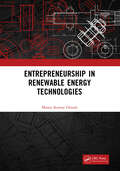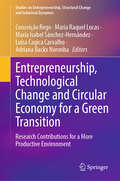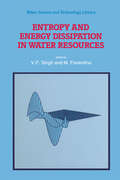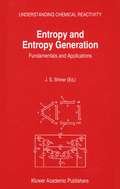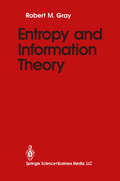- Table View
- List View
Entrepreneurship in Renewable Energy Technologies
by Manoj Kumar GhosalThis book focusses on various options of taking up ventures for starting entrepreneurship in small/large scale in the field of renewable energy technologies. The book covers the fundamentals of entrepreneurship, renewable energy resources, their technologies involved and applications along with financial evaluations. The book will cater to the needs of students, researchers, various stakeholders, entrepreneurs etc. by providing valuable information on renewable energy technologies and their applications in developing entrepreneurship and establishing enterprise at individual level, specifically focusing on low carbon technology for sustenance of environment which is becoming increasingly important.
Entrepreneurship in the Balkans: Diversity, Support and Prospects
by Veland Ramadani and Robert C. SchneiderThis book represents a comprehensive state-of-the-art picture of entrepreneurship and small business management issues in the Balkans region. It provides major theoretical and empirical evidence that offers a brighter view of these fields and aims to open up opportunities for greater dialogue in public policy. The readers would be able to enhance their knowledge on small businesses and innovation issues in the Balkans. An outcome of a long lasting endeavour, this book includes contributions of highly reputed authors and experts from the Balkans’ countries. Features forewords by two well-known personalities of this field, Leo Paul Dana and Alain Fayolle.
Entrepreneurship, Innovation and Economic Crisis: Lessons for Research, Policy and Practice
by Klaus Rüdiger Marta Peris-Ortiz Alicia Blanco-GonzálezThis book looks at entrepreneurship and innovation as ways out of the economic crisis in Europe and other regions, and examines the main theoretical issues and practices related to this analysis. The volume addresses such questions as: From an institutional perspective, how do economic crisis conditions affect different types of entrepreneurs and entrepreneurship? Is it useful for public policymakers and entrepreneurs to understand the basic characteristics of entrepreneurial activity, relations between the institutional environment and entrepreneurship and among entrepreneurship, innovation and social change? Featuring case studies from several industries and countries, and a variety of methodological, theoretical, and empirical approaches, the authors build a compelling narrative on the dynamics of entrepreneurship and innovation as drivers of economic growth and organizational renewal. They demonstrate that the strategic and operational relationships that entrepreneurship creates within and outside the enterprise are a fundamental route for leading and mobilizing economic and social resources that permit innovation at the organizational level and in relationships with suppliers, customers, and other stakeholders - in turn, enabling technological innovation, creating new revenue streams through new productive activities and new demand, and ultimately facilitating emergence from economic crisis. The authors consider social, gender, and generational aspects of entrepreneurship, as well as the institutional conditions necessary to promote entrepreneurial activity.
Entrepreneurship, Technological Change and Circular Economy for a Green Transition: Research Contributions for a More Productive Environment (Studies on Entrepreneurship, Structural Change and Industrial Dynamics)
by Conceição Rego Maria Raquel Lucas María Isabel Sánchez-Hernández Luísa Cagica Carvalho Adriana Backx NoronhaThis book is a comprehensive and timely publication that aims to be an essential reference source, building on contemporary research in the fields of circular economy and green transition in relation to entrepreneurship and technological change. This book aims to address a range of approaches including, but not limited to, the conceptual, theoretical, and case studies related to the topics of the book. The topical focus is on how circular economy contributions, energy infrastructure, green transition, and digital transformation are contributing to attaining the Sustainable Development Goals (SDGs). The expert contributions in the book particularly help us learn more about the answers to the current challenges of the green transition as well as how the necessary technological change will impact, mainly, the enterprises and the field of agriculture production and agribusiness. The book is mainly intended to support an academic audience (academics, university teachers, researchers, and post-graduate students – both Master's and Doctorate levels). In addition, this book will be of benefit to institutional experts, developers, and researchers in the fields of Entrepreneurship and technological change in circular economy and green transition.
Entrepreneurship, Technology Commercialisation, and Innovation Policy in Africa
by Joe Amadi-Echendu Chux Daniels Mafini DossoThis book provides a comprehensive overview of role of entrepreneurship, technology commercialisation and innovation policy for the achievement of economic development and prosperity in African societies. It adopts a broad innovation systems approach. The book examines entrepreneurship, innovation, and technology commercialisation alongside context-specific factors associated with them. It also provides an interdisciplinary perspective, by discussing the above disciplines in a connected way. This book is presented in three distinct parts. It starts by discussing entrepreneurship and the state of the entrepreneurial ecosystem in Africa. It then moves on to present technology commercialisation in Africa, before finally discussing the future directions for entrepreneurship, technology commercialisation and innovation policy. This broad picture provided in the book enables the reader to grasp the relevant messages, whilst the detailed analysis applies world-class theories and frameworks to deepen the readers understanding of key concepts and issues examined.
Entropie des Wasserdampfes in elementarer Ableitung
by Fritz BürkDieser Buchtitel ist Teil des Digitalisierungsprojekts Springer Book Archives mit Publikationen, die seit den Anfängen des Verlags von 1842 erschienen sind. Der Verlag stellt mit diesem Archiv Quellen für die historische wie auch die disziplingeschichtliche Forschung zur Verfügung, die jeweils im historischen Kontext betrachtet werden müssen. Dieser Titel erschien in der Zeit vor 1945 und wird daher in seiner zeittypischen politisch-ideologischen Ausrichtung vom Verlag nicht beworben.
Entropie für Ingenieure: Erfolgreich das Entropie-Konzept bei energietechnischen Fragestellungen anwenden
by Heinz Herwig Tammo WenterodtFür die Realisierung von energietechnischen Prozessen ist der Zweite Hauptsatz der Thermodynamik entscheidend. Er macht Aussagen über die Wertigkeit von Energie bzw. über die Energieentwertung in energietechnischen Prozessen. Je mehr man darauf angewiesen ist, Energie effektiv zu nutzen, umso mehr müssen solche Überlegungen in den Entwurf, die Planung und die Optimierung energietechnischer Anlagen einbezogen werden. Genau hier setzt das vorliegende Fachbuch an, das anhand von vielen Beispielen den physikalischen Hintergrund erklärt, den Ursachen von Verlusten auf den Grund geht und Möglichkeiten zur Bewertung und zur Verbesserung von Prozessen aufzeigt.
Entropie, Umweltschutz und Rohstoffverbrauch: Eine naturwissenschaftlich ökonomische Untersuchung (Lecture Notes in Economics and Mathematical Systems #214)
by Malte Faber Horst Niemes Gunter StephanEntropies of Condensed Phases and Complex Systems: A First Principles Approach (Springer Theses)
by Christian SpickermannPredicting thermodynamic quantities for chemically realistic systems on the basis of atomistic calculations is still, even today, a nontrivial task. Nonetheless, accurate treatment of inter-particle interactions, in terms of quantum chemical first principles methods, is a prerequisite for many applications, because of the complexity of both reactants and solvents in modern molecular sciences. Currently, a straightforward calculation of thermodynamic properties from these methods is only possible for high-temperature and low- density systems. Although the enthalpy of a system can often be predicted to a good level of precision with this ideal gas approach, calculating the entropy contribution to the free energy is problematic, especially as the density of the system increases. This thesis contains a compact and coherent introduction of basic theoretical features. The foundations are then laid for the development of approaches suitable for calculation of condensed phase entropies on the basis of well-established quantum chemical methods. The main emphasis of this work is on realistic systems in solution, which is the most important environment for chemical synthesis. The presented results demonstrate how isolated molecular concepts typically employed in modern quantum chemistry can be extended for the accurate determination of thermodynamic properties by means of scale- transferring approaches.
Entropy, Absolute Temperature and Coldness in Thermodynamics: Boundary Conditions in Porous Materials (CISM International Centre for Mechanical Sciences #76)
by Ingo MuellerEntropy and Energy: A Universal Competition (Interaction of Mechanics and Mathematics)
by Ingo Müller Wolf WeissIntroductory textbook introducing the concept of competition of entropy and energy with various examples.Thermodynamics textbook explaining the roles of entropy and energy as prime movers of nature.
Entropy and Energy Dissipation in Water Resources (Water Science and Technology Library #9)
by V. P. Singh M. FiorentinoSince the landmark contributions of C. E. Shannon in 1948, and those of E. T. Jaynes about a decade later, applications of the concept of entropy and the principle of maximum entropy have proliterated in science and engineering. Recent years have witnessed a broad range of new and exciting developments in hydrology and water resources using the entropy concept. These have encompassed innovative methods for hydrologic network design, transfer of information, flow forecasting, reliability assessment for water distribution systems, parameter estimation, derivation of probability distributions, drainage-network analysis, sediment yield modeling and pollutant loading, bridge-scour analysis, construction of velocity profiles, comparative evaluation of hydrologic models, and so on. Some of these methods hold great promise for advancement of engineering practice, permitting rational alternatives to conventional approaches. On the other hand, the concepts of energy and energy dissipation are being increasingly applied to a wide spectrum of problems in environmental and water resources. Both entropy and energy dissipation have their origin in thermodynamics, and are related concepts. Yet, many of the developments using entropy seem to be based entirely on statistical interpretation and have seemingly little physical content. For example, most of the entropy-related developments and applications in water resources have been based on the information-theoretic interpretation of entropy. We believe if the power of the entropy concept is to be fully realized, then its physical basis has to be established.
Entropy and Entropy Generation: Fundamentals and Applications (Understanding Chemical Reactivity #18)
by J. S. ShinerEntropy and entropy generation play essential roles in our understanding of many diverse phenomena ranging from cosmology to biology. Their importance is manifest in areas of immediate practical interest such as the provision of global energy as well as in others of a more fundamental flavour such as the source of order and complexity in nature. They also form the basis of most modern formulations of both equilibrium and nonequilibrium thermodynamics. Today much progress is being made in our understanding of entropy and entropy generation in both fundamental aspects and application to concrete problems. The purpose of this volume is to present some of these recent and important results in a manner that not only appeals to the entropy specialist but also makes them accessible to the nonspecialist looking for an overview of the field. This book contains fourteen contributions by leading scientists in their fields. The content covers such topics as quantum thermodynamics, nonlinear processes, gravitational and irreversible thermodynamics, the thermodynamics of Taylor dispersion, higher order transport, the mesoscopic theory of liquid crystals, simulated annealing, information and biological aspects, global energy, photovoltaics, heat and mass transport and nonlinear electrochemical systems. Audience: This work will be of value to physicists, chemists, biologists and engineers interested in the theory and applications of entropy and its generation.
Entropy and Free Energy in Structural Biology: From Thermodynamics to Statistical Mechanics to Computer Simulation (Foundations of Biochemistry and Biophysics)
by Hagai MeirovitchNuclear Structure Physics connects to some of our fundamental questions about the creation of the universe and its basic constituents. At the same time, precise knowledge on the subject has led to the development of many important tools for humankind such as proton therapy and radioactive dating, among others. This book has chapters on some of the crucial and trending research topics in nuclear structure, including the nuclei lying on the extremes of spin, isospin and mass. A better theoretical understanding of these topics is important beyond the confines of the nuclear structure community. Additionally, the book will showcase the applicability and success of the different nuclear effective interaction parameters near the drip line, where hints for level reordering have already been seen, and where one can test the isospin-dependence of the interaction. The book offers comprehensive coverage of the most essential topics, including: • Nuclear Structure of Nuclei at or Near Drip-Lines • Synthesis challenges and properties of Superheavy nuclei • Nuclear Structure and Nuclear models - Ab-initio calculations, cluster models, Shell-model/DSM, RMF, Skyrme • Shell Closure, Magicity and other novel features of nuclei at extremes • Structure of Toroidal, Bubble Nuclei, halo and other exotic nuclei These topics are not only very interesting from a theoretical nuclear physics perspective but are also quite complimentary for ongoing nuclear physics experimental programs worldwide. The book chapters, written by experienced and well-known researchers/experts, will be helpful for master students, graduate students and researchers and serve as a standard and up-to-date research reference book on the topics covered.
Entropy and Free Energy in Structural Biology: From Thermodynamics to Statistical Mechanics to Computer Simulation (Foundations of Biochemistry and Biophysics)
by Hagai MeirovitchNuclear Structure Physics connects to some of our fundamental questions about the creation of the universe and its basic constituents. At the same time, precise knowledge on the subject has led to the development of many important tools for humankind such as proton therapy and radioactive dating, among others. This book has chapters on some of the crucial and trending research topics in nuclear structure, including the nuclei lying on the extremes of spin, isospin and mass. A better theoretical understanding of these topics is important beyond the confines of the nuclear structure community. Additionally, the book will showcase the applicability and success of the different nuclear effective interaction parameters near the drip line, where hints for level reordering have already been seen, and where one can test the isospin-dependence of the interaction. The book offers comprehensive coverage of the most essential topics, including: • Nuclear Structure of Nuclei at or Near Drip-Lines • Synthesis challenges and properties of Superheavy nuclei • Nuclear Structure and Nuclear models - Ab-initio calculations, cluster models, Shell-model/DSM, RMF, Skyrme • Shell Closure, Magicity and other novel features of nuclei at extremes • Structure of Toroidal, Bubble Nuclei, halo and other exotic nuclei These topics are not only very interesting from a theoretical nuclear physics perspective but are also quite complimentary for ongoing nuclear physics experimental programs worldwide. The book chapters, written by experienced and well-known researchers/experts, will be helpful for master students, graduate students and researchers and serve as a standard and up-to-date research reference book on the topics covered.
Entropy and Information (Progress in Mathematical Physics #57)
by Mikhail V. VolkensteinThis is just...entropy, he said, thinking that this explained everything, and he repeated the strange word a few times. 1 ? Karel Capek , “Krakatit” This “strange word” denotes one of the most basic quantities of the physics of heat phenomena, that is, of thermodynamics. Although the concept of entropy did indeed originate in thermodynamics, it later became clear that it was a more universal concept, of fundamental signi?cance for chemistry and biology, as well as physics. Although the concept of energy is usually considered more important and easier to grasp, it turns out, as we shall see, that the idea of entropy is just as substantial—and moreover not all that complicated. We can compute or measure the quantity of energy contained in this sheet of paper, and the same is true of its entropy. Furthermore, entropy has remarkable properties. Our galaxy, the solar system, and the biosphere all take their being from entropy, as a result of its transferenceto the surrounding medium. Thereis a surprisingconnectionbetween entropyandinformation,thatis,thetotalintelligencecommunicatedbyamessage. All of this is expounded in the present book, thereby conveying informationto the readeranddecreasinghis entropy;butitis uptothe readertodecidehowvaluable this information might be.
Entropy and Information Optics: Connecting Information and Time, Second Edition (Optical Science and Engineering)
by Francis T.S. YuThis book shows there is a profound connection between information and entropy. Without this connection, information would be more difficult to apply to science. This book covers the connection and the application to modern optics and radar imaging. It shows that there exists a profound relationship between Einstein’s relativity theory and Schröinger’s quantum mechanics, by means of the uncertainty principle. In due of the uncertainty relation, this book shows that every bit of information takes time and energy to transfer, to create and to observe. The new edition contains 3 new chapters on radar imaging with optics, science in the myth of information, and time and the enigma of space.
Entropy and Information Optics: Connecting Information and Time, Second Edition (Optical Science and Engineering)
by Francis T.S. YuThis book shows there is a profound connection between information and entropy. Without this connection, information would be more difficult to apply to science. This book covers the connection and the application to modern optics and radar imaging. It shows that there exists a profound relationship between Einstein’s relativity theory and Schröinger’s quantum mechanics, by means of the uncertainty principle. In due of the uncertainty relation, this book shows that every bit of information takes time and energy to transfer, to create and to observe. The new edition contains 3 new chapters on radar imaging with optics, science in the myth of information, and time and the enigma of space.
Entropy And Its Physical Meaning
by J. S. DugdaleThis text gives students a clear and easily understood introduction to entropy - a central concept in thermodynamics, but one which is often regarded as the most difficult to grasp. Professor Dugdale first presents a classical and historical view of entropy, looking in detail at the scientists who developed the concept, and at how they arrived at their ideas. This is followed by a statistical treatment which provides a more physical portrait of entropy, relating it to disorder and showing how physical and chemical systems tend to states of order at low temperatures. Dugdale includes here a brief account of some of the more intriguing manifestations of order in properties such as superconductivity and superfluidity.Entropy and Its Physical Meaning also includes a number of exercises which can be used for both self- learning and class work. It is intended to provide a complete understanding of the concept of entropy, making it valuable reading for undergraduates in physics, physical sciences and engineering, and for students studying thermodynamics within other science courses such as meteorology, biology and medicine.
Entropy and the Magic Flute
by Harold J. MorowitzHarold Morowitz has long been regarded highly both as an eminent scientist and as an accomplished science writer. The essays in The Wine of Life, his first collection, were hailed by C.P. Snow as "some of the wisest, wittiest and best informed that I have read," and Carl Sagan called them "a delight to read." In later volumes such as Mayonnaise and the Origin of Life and The Thermodynamics of Pizza, he has established a reputation for a wide-ranging intellect, an ability to see unexpected connections and draw striking parallels, and a talent for communicating scientific ideas with optimism and wit. Kirkus Reviews praised Mayonnaise as "wonderfully diverting and very wise." Nature wrote of Thermodynamics, "his chocolate-coated nuggets of science will continue to entertain and do surreptitious good." With Entropy and the Magic Flute, Morowitz once again offers an appealing mix of brief reflections on everything from litmus paper to the hippopotamus to the sociology of Palo Alto coffee shops. Many of these pieces are appreciations of scientists that Morowitz holds in high regard. In the title piece, for instance, Morowitz tells of his pilgrimage to the grave of Ludwig Boltzmann, buried in the same cemetery--Vienna's Central Cemetery--as Beethoven, Schubert, and Brahms. He also writes of J. Willard Gibbs ("thought by many to be the greatest scientist yet produced by the United States"), Jean Perrin (author of Les Atomes, a now-forgotten classic that convinced virtually everyone in science of the validity of the atomic hypothesis), Einstein, Newton (on the occasion of the 300th anniversary of his Principia, a date that passed virtually unnoticed except by Morowitz), Murray Gell-Mann, and Aristotle. Of Aristotle, Morowitz observes that "most people whose information comes from academic philosophy fail to appreciate that--among his many fields of expertise--first and foremost, Aristotle was a biologist." Indeed, fully a third of Aristotle's writings are on the life sciences, almost all of which has been left out of standard editions of his work. Many other pieces focus on health issues--such as America's obsession with cheese toppings, the addiction to smoking of otherwise intelligent people, questionable obstetric practices--and several touch upon ethics, whistle-blowing, and scientific research. There is also a fascinating piece on the American Type Culture Collection, a zoo or warehouse for microbes that houses some 11,800 strains of bacteria, and over 3,000 specimens of protozoa, algae, plasmids, and oncogenes. Here then are over forty light, graceful essays in which one of our wisest experimental biologists comments on issues of science, technology, society, philosophy, and the arts.
Entropy and the Second Law of Thermodynamics: ... or Why Things Tend to Go Wrong and Seem to Get Worse
by Robert FleckThis book is a brief and accessible popular science text intended for a broad audience and of particular interest also to science students and specialists. Using a minimum of mathematics, a number of qualitative and quantitative examples, and clear illustrations, the author explains the science of thermodynamics in its full historical context, focusing on the concepts of energy and its availability and transformation in thermodynamic processes. His ultimate aim is to gain a deep understanding of the second law—the increase of entropy—and its rather disheartening message of a universe descending inexorably into chaos and disorder. It also examines the connection between the second law and why things go wrong in our daily lives. Readers will enhance their science literacy and feel more at home on the science side of author C. P. Snow's celebrated two-culture, science-humanities divide, and hopefully will feel more at home in the universe knowing that the disorder we deal with in our daily lives is not anyone's fault but Nature's.
Entropy and the Tao of Counting: A Brief Introduction to Statistical Mechanics and the Second Law of Thermodynamics (SpringerBriefs in Physics)
by Kim SharpThis book provides a complete and accurate atomic level statistical mechanical explanation of entropy and the second law of thermodynamics. It assumes only a basic knowledge of mechanics and requires no knowledge of calculus. The treatment uses primarily geometric arguments and college level algebra. Quantitative examples are given at each stage to buttress physical understanding. This text is of benefit to undergraduate and graduate students, as well as educators and researchers in the physical sciences (whether or not they have taken a thermodynamics course) who want to understand or teach the atomic/molecular origins of entropy and the second law. It is particularly aimed at those who, due to insufficient mathematical background or because of their area of study, are not going to take a traditional statistical mechanics course.
Entropy Based Design and Analysis of Fluids Engineering Systems
by Greg F. Naterer Jose A. CamberosFrom engineering fluid mechanics to power systems, information coding theory and other fields, entropy is key to maximizing performance in engineering systems. It serves a vital role in achieving the upper limits of efficiency of industrial processes and quality of manufactured products. Entropy based design (EBD) can shed new light on various flow
